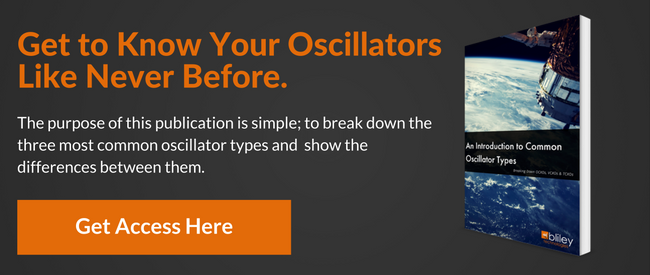
Temperature compensated crystal oscillators (TCXOs) are widely used in applications where accurate frequency sources are needed. Because they're less expensive and smaller than oven controlled crystal oscillators (OCXOs), they offer an ideal solution for many portable units that require a reasonably accurate source.
In this blog, we'll review several performance qualities of TCXOs, as well as four common types.
TCXO Performance Qualities
A standard TCXO has quite a few performance qualities. Some of the most common performance figures are summarized below.
Temperature Performance
The TCXO's temperature performance is better than that of a normal crystal oscillator. Typically, figures of between 10 to 40 times improvement can be seen. Figures of better than ±1.5 ppm over a 0 to 70°C temperature range are difficult to achieve, as they then fall into a high-precision category where costs increase significantly.
Power Dissipation
The power dissipation of a TCXO will be greater than an ordinary oscillator because of the additional circuitry required. The cost will also be greater.
Keep in mind that it will take a short period of time after start up for the oscillator to stabilize. This may be to the order of 100 ms or possibly longer, depending upon the design.
Output Format & Level
With many TCXOs being used for driving digital circuits, most of the small oscillator packages produce what is termed a clipped sine wave. This is suitable for driving a logic circuit, although in many cases it's wise to put it through a logic buffer to ensure it's sufficiently square. Often, the output is an open collector circuit. If a sine wave output is required, then this must be chosen at the outset and it will limit the choices available.
Related: Which Crystal Oscillator Output Signal Is Best for Your Application?
Power Requirements
The actual power requirements will depend upon the device. Many operate from supplies of 3 V and may draw as little as 2 mA, although this will depend upon the TCXO type, the manufacturer, and the particular device chosen.
Package
TCXOs can be supplied in a variety of packages depending upon the design and the requirements of the end user. The most common form of construction is to build the circuit on a small printed circuit board (PCB) that can be housed in a flat metal package. This is then suitable for mounting onto the main circuit board of the overall equipment. Since the crystal itself is sealed, it isn't critical (or even required for most applications) to seal the overall TCXO package.
Note: Package sizes such as 5x3.2x1.5 mm or 5x3.5x1 mm are widely used for TCXOs, but smaller packages are available if required.
Related: The TCXO Oscillator: 5 Elements of Temperature Compensated Oscillators
4 Common Types of TCXOs
Although temperature compensated crystal oscillators are typically referred to as TCXOs, more detailed names are used occasionally to denote the technique used to provide the temperature compensation.
ADTCXO
Analog digital TCXOs (ADTCXOs) have been used widely in cell phones. They employ analog technology to provide temperature correction to the oscillator. One advantage of ADTCXOs is that they change slowly and don't experience phase jumps (which occur with some all-digital types).
DTCXO
The digital TCXO (DTCXO) uses a temperature sensor first, and then logic and mathematical functions use digital circuitry, along with a lookup table. The resulting digital correction figure is converted to an analogue signal using a digital-to-analogue converter (DAC).
DCXO
The digitally compensated crystal oscillator (DCXO) is a form of TCXO where any correction is calculated by the host processor within the equipment. In this way, the TCXO is not a separate entity, but the processing is incorporated within that of the overall equipment. This can help save costs in some instances.
MCXO
The microcomputer compensated crystal oscillator (MCXO) uses a microprocessor to provide a considerably increased level of processing and more accurate compensation under a variety of circumstances. While their performance is a little higher than other TCXOs, they are also more expensive.
Related: Crystal Oscillators: The Beginner's Guide (OCXO, TCXO, VCXO, & Clocks)
Is a TCXO Right for Your Application?
We hope this blog has given you a better understanding of TCXOs, their performance qualities, and what kinds are available.
Need a TCXO for your application? Browse our full line of crystal oscillators.






